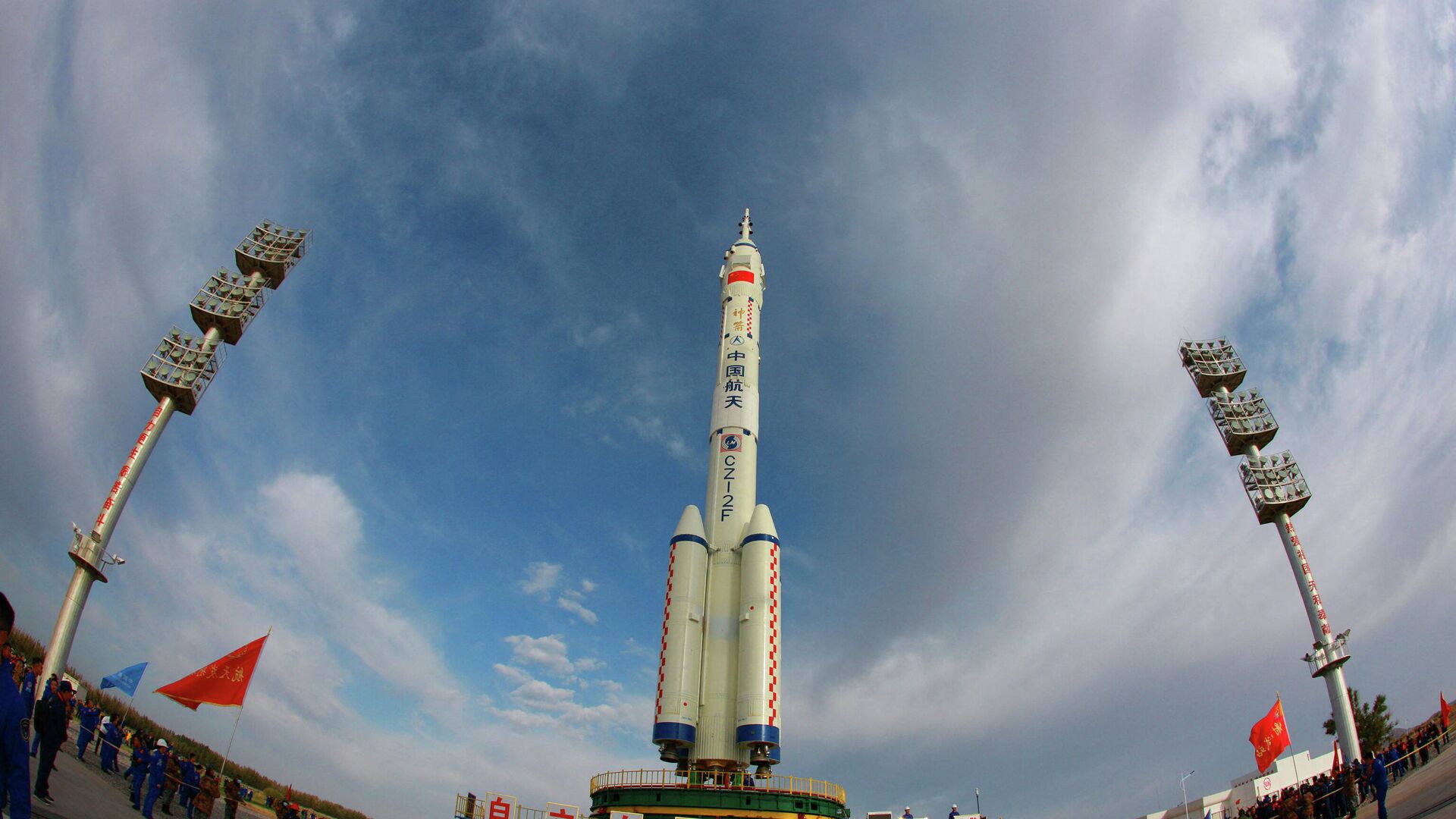https://sputnikglobe.com/20211017/china-tested-new-space-capability-with-hypersonic-missile-in-august---report-1089978423.html
China Tested New Space Capability With Hypersonic Missile in August - Report
China Tested New Space Capability With Hypersonic Missile in August - Report
Sputnik International
According to a report, China has tested a nuclear-capable hypersonic glide missile that travels into space and circles the globe in an orbital-like fashion... 17.10.2021, Sputnik International
2021-10-17T02:52+0000
2021-10-17T02:52+0000
2021-10-17T02:52+0000
us
china
rocket
missile tests
https://cdn1.img.sputnikglobe.com/img/07e5/0a/0f/1089955426_0:0:3071:1728_1920x0_80_0_0_f3fac72611da19c1e5bd1682bcd679d6.jpg
The test, which was confirmed by five officials, proves China has advanced space capability that “caught the US government by surprise,” the Financial Times reported.Defense Department spokesman John Kirby insisted that he would not comment on the specifics of the report but added:“That is one reason why we hold China as our number one pacing challenge.”The trial flight is said to have taken place around August, with the boost-glide vehicle being lifted into space by a Long March 2C rocket.The tested hypersonic glide vehicle reportedly missed its target by two-dozen miles, but nonetheless demonstrates China’s “astounding progress” on hypersonic weapons — the same ones that Russia, the US and China have all been working on.Russia tested one such missile in July, while the US plans to dress all of the Navy’s destroyers with them.Hypersonic missiles, like traditional ballistic missiles which can deliver nuclear weapons, are known to travel five times faster than the speed of sound.Unlike ballistic missiles that fly high into space in an arc to reach their target, hypersonic missiles fly on a lower flight path in the atmosphere, to potentially reach a target more quickly.Crucially, a hypersonic missile is hard to stop, since they fly and maneuver to avoid detection and swerve defensive countermeasures.Last month, US Air Force Secretary Frank Kendall reportedly warned that China could be heading for a first-strike nuclear capability — including the potential for “global strikes… from space” — urging the US to accelerate its own weapons development to keep peace with Beijing.“If they continue down the path that they seem to be on—to substantially increase their ICBM force—they will have a de facto first-strike capability,” Kendall told reporters at the Air Force Association’s annual conference outside Washington, D.C.Kendall further suggested that China was developing something akin to the “Fractional Orbital Bombardment System” that the USSR deployed for part of the Cold War.In his second major speech, Kendall deliberately called out various Chinese weapons developments as reason for concern.“You're gonna get tired of hearing me talk about China and the pacing threat that we face,” he reportedly said at a press conference a few hours after his speech.Chinese Minister Counselor and Spokesperson Liu Pengyu reportedly said the country’s military policy was “defensive in nature.”“We don’t have a global strategy and plans of military operations like the US does,” Liu said. “And we are not at all interested in having an arms race with other countries.”While countries like the US have developed systems designed to defend against cruise and ballistic missiles,there is concern about a gap in the military’s ability to track and defeat low-flying hypersonic weapons.China has been aggressively investing in new defense and other technologies to defend against the US, according to a recent report by the US Congressional Research Service.The reported test comes as US-China tensions have intensified and Beijing has stepped up military activity near Taiwan.
china
Sputnik International
feedback@sputniknews.com
+74956456601
MIA „Rosiya Segodnya“
2021
Adriana Montes
https://cdn1.img.sputnikglobe.com/img/07e5/09/10/1089141767_0:89:1270:1359_100x100_80_0_0_83cb4d432e11a31f4608d8cb59ecf006.jpg
Adriana Montes
https://cdn1.img.sputnikglobe.com/img/07e5/09/10/1089141767_0:89:1270:1359_100x100_80_0_0_83cb4d432e11a31f4608d8cb59ecf006.jpg
News
en_EN
Sputnik International
feedback@sputniknews.com
+74956456601
MIA „Rosiya Segodnya“
Sputnik International
feedback@sputniknews.com
+74956456601
MIA „Rosiya Segodnya“
Adriana Montes
https://cdn1.img.sputnikglobe.com/img/07e5/09/10/1089141767_0:89:1270:1359_100x100_80_0_0_83cb4d432e11a31f4608d8cb59ecf006.jpg
us, china, rocket, missile tests
us, china, rocket, missile tests
China Tested New Space Capability With Hypersonic Missile in August - Report
According to a report, China has tested a nuclear-capable hypersonic glide missile that travels into space and circles the globe in an orbital-like fashion before speeding through the atmosphere toward its target.
The test, which was confirmed by five officials, proves China has advanced space capability that “caught the US government by surprise,” the Financial Times
reported.
Defense Department spokesman John Kirby insisted that he would not comment on the specifics of the report but
added:
“We have made clear our concerns about the military capabilities China continues to pursue, capabilities that only increase tensions in the region and beyond,”
“That is one reason why we hold China as our number one pacing challenge.”
The trial flight is said to have taken place around August, with the boost-glide vehicle being lifted into space by a Long March 2C rocket.
The tested hypersonic glide vehicle reportedly missed its target by two-dozen miles, but nonetheless demonstrates China’s “astounding progress” on hypersonic weapons — the same ones that Russia, the US and China have all been working on.
Russia tested one such missile in July, while the US plans to dress all of the Navy’s destroyers with them.
Hypersonic missiles, like traditional ballistic missiles which can deliver nuclear weapons, are known to travel five times faster than the speed of sound.
Unlike ballistic missiles that fly high into space in an arc to reach their target, hypersonic missiles fly on a lower flight path in the atmosphere, to potentially reach a target more quickly.
Crucially, a hypersonic missile is hard to stop, since they fly and maneuver to avoid detection and swerve defensive countermeasures.
Last month, US Air Force Secretary Frank Kendall reportedly warned that China could be heading for a first-strike nuclear capability — including the potential for “global strikes… from space” — urging the US to accelerate its own weapons development to keep peace with Beijing. “If they continue down the path that they seem to be on—to substantially increase their ICBM force—they will have a de facto first-strike capability,” Kendall told reporters at the Air Force Association’s annual conference outside Washington, D.C.
Kendall further suggested that China was developing something akin to the “Fractional Orbital Bombardment System” that the USSR deployed for part of the Cold War.
“If you use that kind of an approach, you don’t have to use a traditional ICBM trajectory. It’s a way to avoid defenses and missile warning systems,” said Kendall
In his second major speech, Kendall deliberately called out various Chinese weapons developments as reason for concern.
“You're gonna get tired of hearing me talk about China and the pacing threat that we face,” he
reportedly said at a press conference a few hours after his speech.
Chinese Minister Counselor and Spokesperson Liu Pengyu
reportedly said the country’s military policy was “defensive in nature.”
“We don’t have a global strategy and plans of military operations like the US does,” Liu said. “And we are not at all interested in having an arms race with other countries.”
While countries like the US have developed systems designed to defend against cruise and ballistic missiles,
there is concern about a gap in the military’s ability to track and defeat low-flying hypersonic weapons.
China has been aggressively investing in new defense and other technologies to defend against the US, according to a recent
report by the US Congressional Research Service.
The reported test comes as US-China tensions have intensified and Beijing has stepped up military activity near Taiwan.




